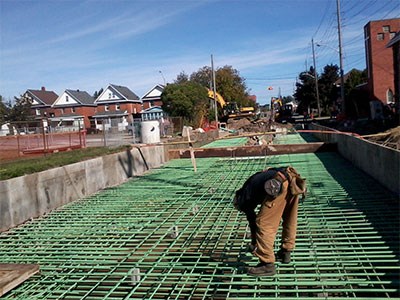The replacement of the Fort Creek Aqueduct in Sault Ste. Marie is one of biggest municipal infrastructure projects in the city’s recent history, and yet once it’s complete, it will be largely invisible to the naked eye.
“You’re spending $30 million, and when you pave over it and put grass on it, it looks like you weren’t even there,” said Don Elliott, the city’s director of engineering services. “It’s not like building a building that we can see, but it certainly is critical infrastructure.”
The decades-old aqueduct — a series of underground channels or ditches designed to divert water runoff — was constructed to prevent flooding from Fort Creek and encompasses several city blocks in the city’s west end. While it’s undergone minor repairs over the years, it’s never had a major overhaul, Elliott said.
But the aging infrastructure no longer meets the city’s design standards, and, in some areas, the aqueduct is actually undersized to meet the city’s needs.
The city will tear out the old concrete infrastructure, rebuild it, and waterproof it. In some areas, Elliott said, the city will actually “twin” the aqueduct, creating relief areas to handle a larger flow of water.
“It’s showing signs of its age by little minor failures here and there,” he said. “We inspect it every two years, do structural inspections, and there are some spots on it that were starting to fail, so we knew had to start budgeting to get it replaced.”
With a total price tag of $31.2 million, the project will be funded three ways by the city, FedNor, and the Northern Ontario Heritage Fund Corp. (NOHFC), which are each contributing $10.4 million.
Phase one of the project was completed in 2013 using city capital, and Sault contractor Jobst Construction is currently working on phase two, which is being done in two parts through 2015 and 2016. The entire project is expected to take between six and eight years.
Elliott said while it’s difficult to predict costs so far in advance, the city is hopeful it can complete the project within budget. Applications to the Ontario Community Infrastructure Fund and Build Canada Fund are open until October 2021.
Each new phase will to go out to public tender, and Elliott said there should be opportunities for local contractors like Jobst to get in on the work.
“If there’s a big enough job, maybe there are some outside contractors that might be interested, but we’re hoping there’s construction capacity in the Sault for our local contractors,” he said. “They are certainly capable of doing it.”
While concrete work is ideally done during the summer months to allow for the material to cure properly, some work may be able to be done during the winter months, Elliott said. The first portion of phase two will be complete soon, and then the consultant will start working on the design for the second part.
Once complete, the new aqueduct will have a 50-year lifespan, but “with proper construction, it may last longer than that,” Elliott said.
One of the biggest challenges, he noted, will be undertaking work on the portion of the aqueduct that spans Wellington Street West, one of the city’s busiest main thoroughfares. He said every effort will be made to minimize disruption to the businesses and traffic along that route.
“We really appreciate the patience of the public when we do these kinds of projects,” Elliott said. “They’re high profile, especially when they’re on an artery, and we want to be done in as timely a fashion as possible. So everybody that is inconvenienced, we appreciate their patience.”




